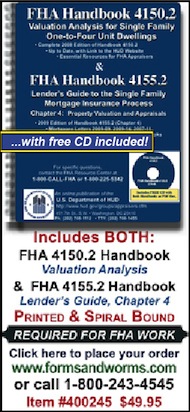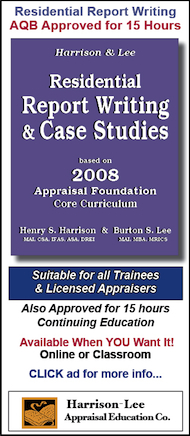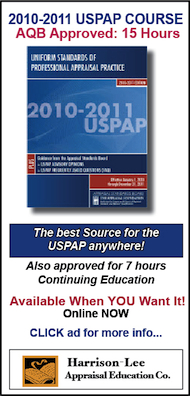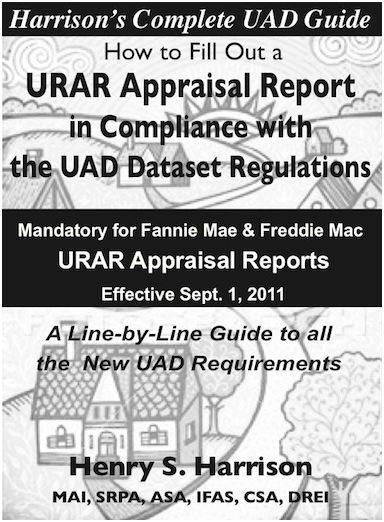Feature Article
by Henry S Harrison
As of September 1st, 2011, appraisers will be required to make some significant changes in the way they prepare the URAR because Fannie Mae, Freddie Mac, FHA, and the VA are going to require all appraisal reports be transmitted electronically in a standardized format. All URAR appraisal reports with an effective date on or after the first of September submitted to Fannie Mae or Freddie Mac will have to meet the new Uniform Appraisal Dataset (UAD) standards (and shortly for FHA and VA too).
The UAD requirements have been designed to allow appraisers to make appraisals that comply with the USPAP, and include everything the appraiser believes is necessary to make a credible appraisal as required by the USPAP. Appraisers should start making appraisals that meet UAD standards as soon as possible. To meet these highly specific requirements, they will need a form-fill input program sold by an approved software vendor. The software dealers in the appraisal industry are gearing up to make their program output coincide with the UAD requirements, and have it available soon so that appraisers have sufficient time to learn how to use the new UAD format.
The UAD is highly specific about the style, format and presentation of all data entered on the URAR. The biggest change, in my opinion, is that appraisers will no longer be able to use qualifiers such as “poor”, “fair”, “good” or “very good” in their property quality and condition ratings. Under UAD, only six quality ratings are feasible: Q1, Q2, Q3, Q4, Q5 or Q6. Similarly, six precise condition ratings are provided: C1, C2, C3, C4, C5 or C6. Each of these ratings is defined by the UAD guidelines, and appraisers are not permitted to modify them with plus “+” or minus “-” signs, or any other modifier. Read More...
Interview with Henry S. Harrison
Interview with Henry S. Harrison
by his wife Ruth Lambert, Editor, Real Estate Valuation Magazine Online
Henry - can you explain to our readers what you are working on now?
Henry (H2): For the past few weeks, we have been very involved with the birth of our 5th grandchild, Sterling Harrison Muchnick, born February 23rd. Now I am back at work on my latest book "Harrison's Complete UAD Guide for the URAR."
What is the UAD? How will it affect appraisers?
H2: According to Fannie Mae and Freddie Mac (aka the GSEs), they "have developed the Uniform Mortgage Data Program (UMDP) to enhance the accuracy and quality of loan data delivered to each GSE. The Uniform Appraisal Dataset (UAD) is a key component which defines all fields required for an appraisal submission on one of four standard appraisal forms, and standardizes definitions and responses for a key subset of fields." What this means is that soon Fannie and Freddie will no longer accept appraisals on paper — only electronic transmissions from the lenders. In addition, they will require that all these appraisals be formatted exactly as delineated in the UAD, or their computers will reject them.
Read More...
Featured Article
The 5 Rules of Working From Home
based on an article by David Prince in Real Simple Magazine
How to structure your time, avoid distractions,
and keep yourself, your boss and your family happy.
1. Figure Out if It’s Right for You
If you thrive on the camaraderie of water cooler chitchat or are tempted to rush off to a sale at the mall without a watchful eye to tether you down, you probably aren’t the best candidate for working alone at home. Notes Tory Johnson in her book Fired to Hired ($14, Berkley Trade, add our AMAZON link here): “Many of us would opt to work from home. We think we'll save on childcare expenses and commuting time, but it isn’t for everyone.”
If you want to try telecommuting which is certainly gaining in acceptance, put your request in writing, address your communication strategy (e.g., your planned email and phone check-ins at specific times of day) and suggest that you and your company arrange a trial period. You may decide to telecommute just one day a week to start, or one week each month.
If you are a sole practitioner, learn about the legal aspects of self-employment at www.nolo.com, a website for small businesses. (To find out about health-care options by state, go to ehealthinsurance.com).
2. Set Up a Real Office
The most crucial factor in successful home-based work arrangements is creating a work-friendly environment. You need a dedicated, conducive, ergonomic, streamlined space. Don't imagine you can hunker down comfortably at your children's Play-Doh table, or the diningroom table.
When you sit at your desk, facing your computer or desk top workspace, be sure to follow these rules:
• Angle your pelvis so that it’s slightly open, to avoid back and hip pain.
• Keep your torso relaxed but erect.
• Rest your hands comfortably on the desktop with elbows at 90 degrees
• Keep your feet flat on the floor.
Feature Article
by
Henry S Harrison & Ruth Lambert
Recently, we returned from a 17 day trip to China. We have tried to capture in this article some of the highlights of our experience and what we learned about China. The article is divided into two parts. Part 1 summarizes what we saw and learned. Part 2 is a chronological day-by-day description of the trip, with many pictures.
Part 1 - AN OVERVIEW
China is a big country with a land area about the same as the US, with a gigantic population of over 1.3 billion people. Like the US, most of the action is in its coastal cities. Unlike the United States, China has only one coastline, on the East China Sea.
Read More...
















